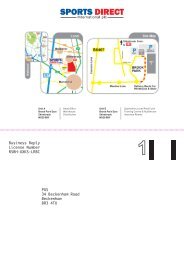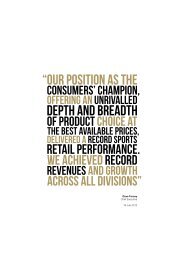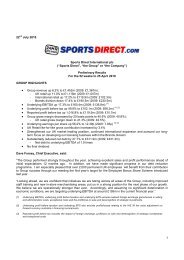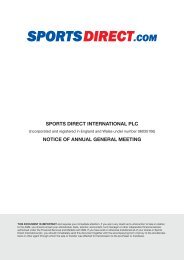Sports Direct Is The UK's Leading Sports Retailer - Sports Direct ...
Sports Direct Is The UK's Leading Sports Retailer - Sports Direct ...
Sports Direct Is The UK's Leading Sports Retailer - Sports Direct ...
You also want an ePaper? Increase the reach of your titles
YUMPU automatically turns print PDFs into web optimized ePapers that Google loves.
notes to the finanCial statements for the 52 weeks ended 26 april 2009 Continued<br />
1. aCCountinG poliCies Continued<br />
If the recoverable amount of an asset (or cash generating unit) is estimated<br />
to be less than its carrying amount, the carrying amount of the asset (cash<br />
generating unit) is reduced to its recoverable amount. An impairment loss is<br />
recognised as an expense immediately, unless the relevant asset is carried at a<br />
revalued amount, in which case the impairment loss is treated as a revaluation<br />
decrease.<br />
Impairment losses recognised for cash generating units, to which goodwill has<br />
been allocated, are credited initially to the carrying amount of goodwill. Any<br />
remaining impairment loss is charged pro rata to the other assets in the cash<br />
generating unit.<br />
Where an impairment loss subsequently reverses, the carrying amount of<br />
the asset (cash generating unit) is increased to the revised estimate of its<br />
recoverable amount, but so that the increased carrying amount does not exceed<br />
the carrying amount that would have been determined had no impairment loss<br />
been recognised for the asset (cash generating unit) in prior periods. A reversal<br />
of an impairment loss is recognised in the income statement immediately.<br />
revenue recognition<br />
Revenue is measured at the fair value of the consideration received or<br />
receivable and represents amounts receivable for goods and services provided<br />
in the normal course of business, net of discounts and sales related taxes.<br />
In the case of goods sold through retail stores, revenue is recognised when<br />
goods are sold to the customer, less provision for returns. Accumulated<br />
experience is used to estimate and provide for such returns at the time of the<br />
sale. Retail sales are usually in cash, by debit card or by credit card.<br />
In the case of income generated from trade marks and licences, revenue is<br />
recognised on an accruals basis in accordance with the relevant agreements or<br />
on a transactional basis when revenue is linked to sale or purchase volumes.<br />
Revenue from property related transactions is recognised when the relevant<br />
service is provided.<br />
exceptional items<br />
<strong>The</strong> Group presents as exceptional items on the face of the income statement<br />
those significant items of income and expense which, because of their size,<br />
nature and infrequency of the events giving rise to them, merit separate<br />
presentation to allow shareholders to understand better the elements of<br />
financial performance in the year, so as to facilitate comparison with prior<br />
periods to assess trends in financial performance more readily.<br />
interest income<br />
Interest income is accrued on a time basis, by reference to the principal<br />
outstanding and at the effective interest rate applicable, which is the rate that<br />
exactly discounts estimated future cash receipts through the expected life of the<br />
financial asset to that asset’s net carrying amount.<br />
Government grants and similar income<br />
Income from government grants and similar income such as landlord<br />
contributions and inducements that compensate the Group for the cost of an<br />
asset are recognised in the balance sheet as a deduction in arriving at the<br />
carrying amount of the related asset. This is considered to reflect the true cost<br />
of the asset to the Group. <strong>The</strong> amount is recognised in the consolidated income<br />
statement over the life of the depreciable asset by way of a reduced depreciation<br />
charge. To date the Group has not received government grants in compensation<br />
for expenses charged in the consolidated income statement.<br />
foreign currencies<br />
<strong>The</strong> presentational currency of the Group is Sterling. Foreign currency<br />
transactions are translated into Sterling using the exchange rates prevailing on<br />
the dates of the transactions. Exchange differences arising on the settlement<br />
of monetary items, and on the retranslation of monetary items, are included<br />
in the income statement for the period. Exchange differences arising on<br />
the retranslation of non-monetary items carried at fair value are included<br />
in the income statement for the period except for differences arising on the<br />
retranslation of non-monetary items in respect of which gains and losses which<br />
are recognised directly in equity. For such non-monetary items, any exchange<br />
component of that gain or loss is also recognised directly in equity. Monetary<br />
assets and liabilities denominated in foreign currencies are translated at the<br />
rate of exchange ruling at the balance sheet date. All differences are taken to<br />
the income statement.<br />
On consolidation, the assets and liabilities of foreign operations which have a<br />
functional currency other than Sterling are translated into Sterling at foreign<br />
exchange rates ruling at the balance sheet date. <strong>The</strong> revenues and expenses<br />
of these subsidiary undertakings are translated at average rates applicable<br />
in the period. All resulting exchange differences are recognised as a separate<br />
component of equity.<br />
38<br />
Financial Statements<br />
When a foreign operation is sold, combined exchange differences that have been<br />
recognised as a separate component of equity are recognised in the income<br />
statement as part of the gain or loss on disposal.<br />
In order to mitigate its exposure to certain foreign exchange risks, the Group<br />
enters into forward contracts (See Chief Executive’s report).<br />
inventories<br />
Inventories are valued at lower of cost and net realisable value. Cost includes<br />
the purchase price of the manufactured products, materials, direct labour,<br />
transport costs and a proportion of applicable overheads. Cost is calculated<br />
using FIFO (first in, first out). Net realisable value is based on the estimated<br />
selling price less all estimated selling costs.<br />
loans and receivables<br />
Loans and receivables are recognised initially at fair value and subsequently<br />
measured at amortised cost under the effective interest method less provision<br />
for impairment. Provision for impairment is established when there is objective<br />
evidence that the Group will not be able to collect amounts due according to the<br />
original terms of the receivable. <strong>The</strong> amount of the impairment is the difference<br />
between the asset’s carrying amount and the present value of the estimated<br />
future cash flows, discounted at the original effective interest rate.<br />
Cash and cash equivalents<br />
Cash and cash equivalents comprise cash in hand and on demand deposits held<br />
with banks.<br />
trade and other payables<br />
Trade and other payables are initially measured at fair value, and are<br />
subsequently measured at amortised cost, using the effective interest method.<br />
deferred taxation<br />
Deferred taxation is calculated using the liability method, on temporary<br />
differences arising between the tax bases of assets and liabilities and their<br />
carrying amounts in the consolidated financial statements. However, if the<br />
deferred tax arises from the initial recognition of goodwill or initial recognition<br />
of an asset or liability in a transaction other than a business combination that<br />
at the time of the transaction affects neither accounting nor taxable profit or<br />
loss, it is not accounted for. Deferred tax on temporary differences associated<br />
with shares in subsidiaries and joint ventures is not provided if reversal of<br />
these temporary differences can be controlled by the Group and it is probable<br />
that reversal will not occur in the foreseeable future. In addition, tax losses<br />
available to be carried forward as well as other income tax credits to the Group<br />
are assessed for recognition as deferred tax assets. Deferred tax is determined<br />
using tax rates and laws that have been enacted (or substantially enacted) by<br />
the balance sheet date and are expected to apply when the related deferred tax<br />
asset is realised or the deferred tax liability is settled.<br />
deferred tax liabilities are provided in full.<br />
Deferred tax assets are recognised to the extent that it is probable that future<br />
taxable profits will be available against which the temporary differences can be<br />
utilised.<br />
Changes in deferred tax assets or liabilities are recognised as a component of<br />
tax expense in the income statement, except where they relate to items that are<br />
charged or credited directly to equity in which case the related deferred tax is<br />
also charged or credited directly to equity.<br />
pensions<br />
<strong>The</strong> Group operates pension plans for the benefit of certain employees,<br />
including both defined contribution and defined benefit plans.<br />
In relation to its defined contribution plans, the Group makes contributions to<br />
independently administered plans, the contributions being recognised as an<br />
expense when they fall due. <strong>The</strong> Group has no legal or constructive obligation to<br />
make any further payments to the plans other than the contributions due.<br />
In relation to its defined benefit schemes, the Group recognises in its balance<br />
sheet the present value of its defined benefit obligations less the fair value<br />
of plan assets. <strong>The</strong> current service cost is charged against operating profit.<br />
Interest on the scheme liabilities is included in finance costs and the expected<br />
return on scheme assets is included in finance income.<br />
<strong>The</strong> defined benefit obligation is calculated at each period end by independent<br />
actuaries using the projected unit credit method. <strong>The</strong> present value of the<br />
obligation is determined by discounting the estimated future cash outflows<br />
using interest rates of high quality corporate bonds that are denominated<br />
in the currency in which the benefits will be paid and which have terms to<br />
maturity approximating the terms of the related pension liabilities. Actuarial<br />
gains and losses arising from experience adjustments and changes in actuarial<br />
assumptions are reflected in the statement of recognised income and expense<br />
in the period in which they arise.



![Our ref: [ ] - Sports Direct International](https://img.yumpu.com/19248141/1/184x260/our-ref-sports-direct-international.jpg?quality=85)






![Our ref: [ ] - Sports Direct International](https://img.yumpu.com/18440214/1/184x260/our-ref-sports-direct-international.jpg?quality=85)
